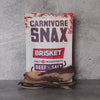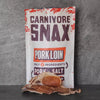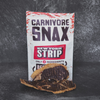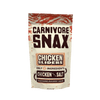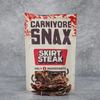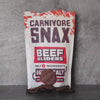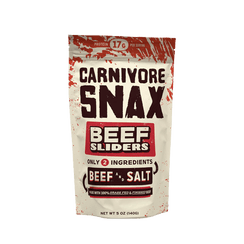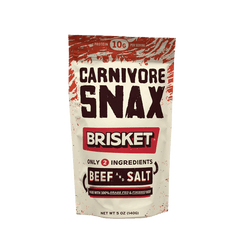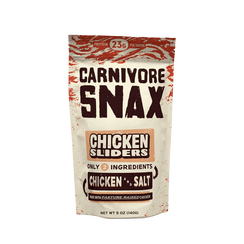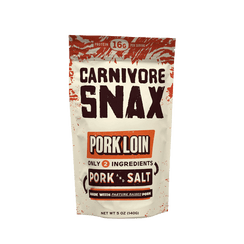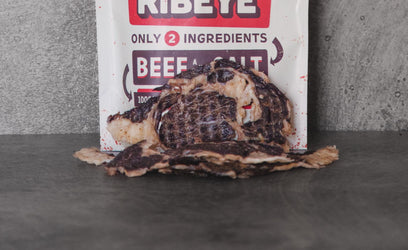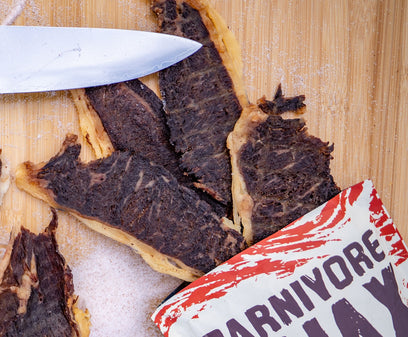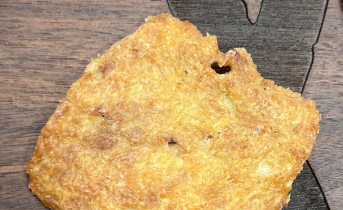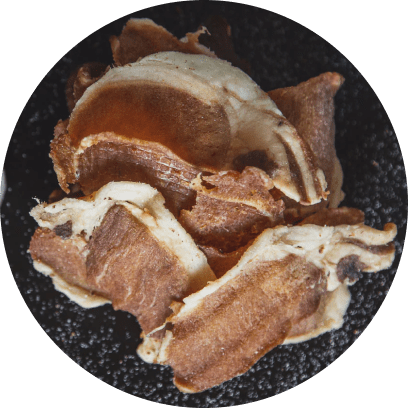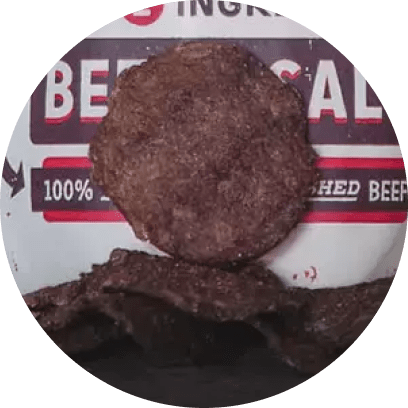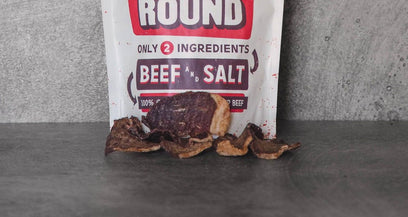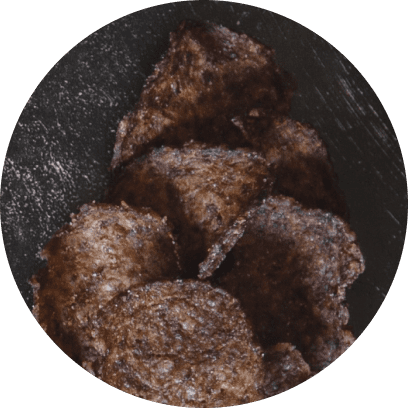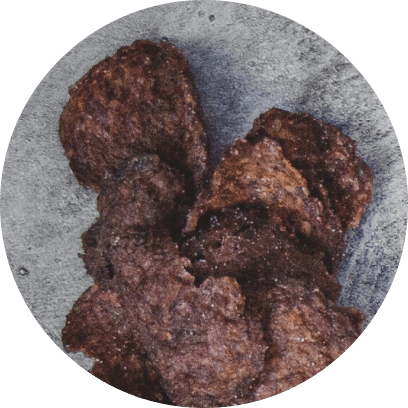THE CARNIVORE DIET BENEFITS




As devoted pet parents, we always strive to give our furry friends the best. Yet, despite our efforts, many commercial pet foods contain ingredients that we'd never dream of eating ourselves.
It's a concerning disparity: if these ingredients aren't good enough for us, why should they be for our beloved pets?
This critical realization is steering a growing number of pet owners towards the carnivore diet for dogs - a natural, meat-based diet aligning with their innate dietary needs.
We’ll unveil the myriad benefits of a carnivore dog diet and walk you through how to get started making the transition, so you can enjoy more years with your pup and give them the life they deserve.
You’ll also discover our delicious carnivore chips. These treats are perfect for both you and your pup, making the transition to a healthier lifestyle enjoyable and rewarding for everyone involved!
The Problems With Traditional Pet Food
Traditional pet food, often found lining the shelves of supermarkets and pet stores, is not always the nutritional panacea it’s made out to be.
So before we discuss the appeal of the dog carnivore diet, let’s assess the shortcomings of traditional diets. Here’s why pet owners who are committed to the health and well-being of their furry companions are seeking something better.
Questionable Ingredients and Nutritional Deficiencies
Many commercial pet foods include ingredients that are far from what dogs would naturally consume. These can include fillers like corn, wheat, and soy, which offer little nutritional value and are often used to bulk up the product inexpensively.
Moreover, these foods frequently contain meat by-products - parts of animals that are deemed unfit for human consumption - rather than whole, quality meats.
The nutritional deficiencies in these foods are a significant concern. While they may meet basic nutritional standards set by pet food regulatory bodies, they often lack the variety and quality of nutrients dogs need for optimal health.
Essential elements like high-quality protein, necessary for muscle development and maintenance, are typically found in lower quantities.
Additionally, the lack of variety in these diets can lead to deficiencies in certain vitamins and minerals, which are vital for a dog's overall health and immune system.
Long-Term Health Impacts of Processed Pet Foods
The long-term consumption of traditional pet food can have various adverse effects on a dog's health. One of the primary concerns is the role of these diets in the development of obesity and related conditions like diabetes.
The high carbohydrate content in many commercial pet foods, along with preservatives and artificial additives, can contribute to weight gain and other metabolic disorders.
Furthermore, there’s growing evidence to suggest that certain ingredients in traditional pet food can lead to allergic reactions and skin issues in dogs. Symptoms like itchy skin, rashes, and gastrointestinal problems can often be traced back to the low-quality ingredients and additives in their diet.
The risk of chronic diseases such as kidney and liver problems, as well as certain types of cancer, has also been linked to the prolonged feeding of processed pet foods.
These health issues are often the result of the cumulative effect of artificial ingredients, preservatives, and an imbalance in essential nutrients. So, let’s look at how a dog carnivore diet can address these shortcomings.
The Appeal of a Dog Carnivore Diet
The carnivore diet for dogs is gaining momentum among pet owners, thanks to its alignment with dogs' ancestral eating patterns and the benefits of carnivore diet in general.
But what is the carnivore diet, exactly? As the name suggests, this diet is solely animal-based - eliminating grains, fruit, and anything non-animal-based. As you’ll discover below, the carnivore diet before and after results are remarkable.
Aligning With Natural Canine Eating Habits
Dogs are carnivores by their biological design. Their digestive systems and nutritional needs are tailored for a diet predominantly consisting of meat.
This is evident from their sharp, pointed teeth for tearing meat, a short gastrointestinal tract optimized for meat digestion, and a strong stomach acid that breaks down proteins and kills bacteria found in raw meat.
The carnivore diet mirrors the natural eating habits of wild canines, offering a diet that is more in tune with what dogs would consume in a natural setting. It primarily consists of fresh meats, bones, and organ meats, providing a nutrient-rich, species-appropriate diet.
This shift to a diet that echoes their ancestral habits is a fundamental aspect of the carnivore diet's appeal, promising a return to a more natural and instinctive way of feeding our pets.
Potential Health Benefits: From Coat to Gut Health
The health benefits of the dog carnivore diet are extensive, impacting various aspects of their well-being. First and foremost is the improvement in coat health.
A diet rich in high-quality proteins and fats leads to a shinier, healthier coat and less shedding. Proteins are the building blocks of hair, and the right balance in a dog's diet can make a noticeable difference in their coat's condition.
Gut health is another area where the carnivore diet excels. This diet can reduce incidents of bloating, gas, and diarrhea by eliminating fillers and carbohydrates that can disrupt the digestive system. It supports a healthy gut microbiome, crucial for nutrient absorption, immune function, and overall health.
Furthermore, the carnivore diet can lead to better weight management and increased energy levels. Dogs fed a meat-rich diet often show improved muscle tone and endurance, reflecting their enhanced physical health.
This diet can also play a role in preventing and managing conditions like diabetes, as it naturally contains lower levels of carbohydrates. The carnivore diet for weight loss is one of the most common reasons humans themselves are switching to this diet, and the same benefit applies to our furry friends.
Oral health is another beneficiary of this diet. Chewing on raw bones and meat can help reduce tartar buildup and promote healthier teeth and gums, a common concern in many dogs fed traditional pet food.
There are other potential benefits of this dietary shift as well. You can learn more about carnivore diet inflammation, carnivore diet and testosterone, and more in our blog.
As you can see, there are many reasons to consider transitioning to the dog carnivore diet. But, it’s important that you’re aware of both the pros and cons of carnivore diet, so let’s assess some precautions to keep in mind before beginning.
Safety and Precautions When Implementing the Carnivore Diet for Dogs
You may be wondering…is the carnivore diet safe for my pet? Generally speaking, yes. However, shifting to a carnivore diet for your dog is a significant change that requires careful consideration and preparation.
Here are key safety measures and precautions to ensure a healthy transition and maintenance of this diet. These tips will also help offset any potential carnivore diet side effects:
- Risk of Nutrient Imbalances: A meat-only diet can lead to an imbalance of nutrients. Dogs require a range of vitamins and minerals for optimal health, and a carnivore diet might lack certain essential elements. It's crucial to understand and address these potential deficiencies to maintain your dog’s health.
- Gastrointestinal Sensitivities: Some dogs may experience digestive issues when transitioning to or maintaining a carnivore diet. Symptoms like diarrhea or constipation can occur, particularly if the change in diet is abrupt. Monitoring your dog's digestive health and making gradual dietary changes can help mitigate these issues.
- Choking Hazards and Bone Safety: Bones are often included in carnivore diets, but they can pose choking hazards or cause damage to the digestive tract. It's important to choose the right type and size of bones for your dog and to supervise them during bone consumption.
- Bacterial Contamination Risks: Feeding raw meat can increase the risk of bacterial contamination such as Salmonella or E. coli. Proper handling, storage, and hygiene practices are essential to reduce this risk for both the pet and the household.
- Allergic Reactions and Food Intolerances: Some dogs might be allergic or intolerant to specific types of meat. Introduce new meats gradually and watch for any signs of allergic reactions, such as itching, redness, or gastrointestinal upset.
Most of these risks can be offset by doing your due diligence as a pet parent and taking care to optimize your pet’s carnivore dog diet carefully. That being said, let’s talk about how to implement a carnivore diet for dogs below!
How to Start Your Pup On the Carnivore Dog Diet
Looking for tips on how to start carnivore diet for dogs? It’s fairly simple and straightforward. Below, we’ll cover everything from the best meat for carnivore diet to how much to eat on carnivore diet, carnivore diet supplements, and more!
Transitioning From Traditional Pet Food to the Carnivore Dog Diet
Transitioning your dog to a carnivore diet is a process that should be undertaken gradually. Start by mixing a small portion of the new carnivore diet food with your dog’s current food.
Gradually increase the amount of the new food while decreasing the old food over a period of several weeks. This slow transition helps your dog’s digestive system adjust without causing gastrointestinal upset.
It's also important to choose the right kind of meats when starting. Begin with leaner meats, as they are easier to digest, and then gradually introduce richer, fattier meats. This allows you to monitor how your dog reacts to different types of meat and adjust the diet accordingly.
Find more carnivore diet meal ideas and carnivore diet sides in our blog.
Raw vs Cooked Meat Considerations
You’ll need to decide whether to follow a raw carnivore diet for dogs or cook meat for your pet. A raw meat diet, often referred to as the BARF diet (Biologically Appropriate Raw Food), is argued to be closer to what dogs would naturally eat in the wild.
Advocates suggest that raw diets can lead to shinier coats, healthier skin, cleaner teeth, and higher energy levels. Raw diets can provide unaltered nutrients and enzymes that cooking might destroy.
However, the risks include potential exposure to pathogens like Salmonella and E. coli. These can be harmful to both the dog and humans in the household.
Dogs with compromised immune systems or certain health conditions might not be suitable for raw diets. It’s crucial to source high-quality, fresh meat and practice rigorous food safety protocols, including proper storage, handling, and cleanliness.
Cooking meat for your dog’s diet can provide peace of mind by reducing the risk of bacterial contamination. It can also make certain types of meat easier to digest and nutrients more accessible. Cooked diets can be particularly beneficial for older dogs or those with certain health issues.
However, cooking can degrade some nutrients, requiring careful planning to ensure that the diet remains balanced and nutritionally complete. Overcooking can also lead to the loss of beneficial enzymes and proteins.
Monitoring Portion Sizes
Adjust portion sizes based on your dog's size, activity level, and caloric needs. Initially, this might require some trial and error. Monitor your dog’s weight and adjust portions accordingly to ensure they maintain a healthy weight.
Monitoring Your Dog's Health During the Transition
As you transition your dog to a carnivore diet, close monitoring is essential. Pay attention to your dog’s stool consistency, appetite, energy levels, and overall demeanor. Changes in stool, such as diarrhea or constipation, can indicate that the transition pace needs to be adjusted.
Regular weigh-ins are also important to ensure your dog is maintaining a healthy weight. A sudden loss or gain can signal that the dietary change isn’t meeting your dog’s nutritional needs.
Additionally, watch for signs of food allergies or sensitivities, such as itching, red skin, or ear infections. If these symptoms appear, consult with your veterinarian to identify the cause and make necessary dietary adjustments.
Get Delicious Treats For Yourself and Your Pup as You Implement the Carnivore Diet for Dogs!
One question many pet parents ask when starting the carnivore dog diet is what kind of treats they can rely on. Anything meat-based is fair play - but for the best 0 carb snacks, look no further than our meat chips.
While these are typically used as carnivore snack ideas for humans, your dog will love them too. They’re ethically sourced from the most elite regenerative farms in the country and feature just two ingredients: meat and salt. They’re a great treat for your pet, and you’re going to love them too!
We have so many healthy meat snacks to choose from, too - from ribeye chips and steak chips to lamb chips, beef chips, brisket chips, chicken chips, and pork chips. No carnivore diet food list is complete without these delicious meat pastries.
So, order yours today and spoil yourself and your pup simultaneously as you embark on the dog carnivore diet!
Final Thoughts on Carnivore Diet for Dogs
In embracing the carnivore diet for dogs, we acknowledge their innate carnivorous nature and cater to their biological dietary needs. This diet, focused on high-quality meats, offers numerous potential benefits, including improved coat health, better digestion, and increased vitality.
However, it's crucial to approach this change thoughtfully, considering factors like raw vs. cooked meat, balancing nutrients, and closely monitoring your dog's health.
You gain access to more carnivore diet hacks in our blog, whether you’re implementing the carnivore dog diet or the carnivore diet for women and men.
Learn about carnivore macros, atkins vs carnivore, carnivore adjacent diet, carnivore vs paleo, best cheese for carnivore diet, keto vs carnivore, carnivore diet coffee, carnivore diet breakfast, cheap carnivore diet, and more.
With careful planning and a vet's guidance, the carnivore diet can be a path to a happier, healthier life for your canine companion. Explore the world of high-quality, nutritious meat-based diets with us, and give your pet the gift of optimal health through the dog carnivore diet!



